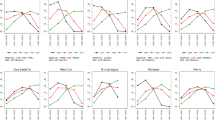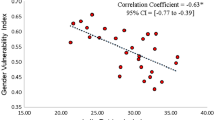Conclusion
Our results indicate that the median income of economic minorities relative to that of whites does not adequately represent the entire income distribution. Among black males, for example, only the lower half of the income distribution experiences a significant change in relative income over the business cycle. The secular trend shows similar variation. Black men at the 25th, 50th, and 75th percentiles experienced significant gains relative to whites in the 1965–77 period while there was little improvement among blacks in the 90th percentile. Using a measure of central tendency to generalize about the entire distribution of an economic minority is a dubious proposition. While this may seem like a trival point, it should be remembered that in today’s political climate such credence is being given to improvement in the general health of the economy as the best way to foster economic progress for economic minorities, while less general remedies, such as affirmative action, are rapidly being deemphasized.
Similar content being viewed by others
References
Burstein, Paul, “Prohibiting Employment Discrimination: Ideas and Politics in the Congressional Debate over Equal Employment Opportunity Legislation,”American Journal of Sociology, vol. 86, November 3, 1980.
Corcoran, Mary, “The Structure of Female Wages,”American Economic Review, vol. 68, no. 2, May 1978.
Denison, Edward F.,Accounting for Slower Economic Growth: The United States in the 1970s, Washington, 1979.
Freeman, Richard B., “The Evaluation of the American Labor Market, 1948–80,” in Martin Feldstein, editor,The American Economy in Transaction, University of Chicago Press, 1980.
Freeman, Richard B.,Black Elite, New York: McGraw Hil, 1976.
Jameson, Kenneth P., “Supply Side Economics: Growth versus Income Distribution,”Challenge, November/December 1980.
Levy, Frank, “Changes in Employment Prospects for Black Males,”Brookings Papers on Economic Activity, no. 2, 1980.
Masters, Stanley M.,Black-White Income Differentials: Empirical Studies and Policy Implications, New York: Academic Press, 1975.
McCrone, Donald J., & Richard J. Hardy, “Civil Rights Policies and the Achievement of Racial Economic Equality, 1948–75,”American Journal of Political Science, vol. 22, no. 1, February 1978.
McCrone, Donald J., & Richard J. Hardy, “The Impact of the Civil Rights Act of 1964 on Women,”Policy Studies Journal, Winter 1978.
Rasmussen, David W, “A Note on the Relative Income of Non-White Men, 1948–1964,”Quarterly Journal of Economics, vol. 84, February 1970.
Smith, James P., & Finis Welch, “Black-White Male Wage Ratios, 1960–70,”American Economic Review, vol. 67, June 1977.
U. S. Bureau of the Census,Current Population Reports: Consumer Income, P-60/113–117, Table 1.
About this article
Cite this article
Burnim, M.L., Rasmussen, D.W. The changing status of economic minorities, 1948–1977. Rev Black Polit Econ 12, 5–14 (1982). https://doi.org/10.1007/BF02903922
Issue Date:
DOI: https://doi.org/10.1007/BF02903922




